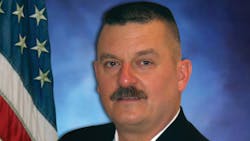The Fire Scene: Fighting Fire with Tank Water
The engine company is the basic unit of service in every fire department. Even departments that have trucks and rescue squads depend heavily on the engines. Not every fire apparatus carries water, but every engine does. How much that they carry can have a dramatic effect on when that tank water can be used.
What tactical operations can be accomplished?
The first limiting factor is the amount of water that’s carried. Some suburban and urban departments have small booster tanks, some of which are as small as 300 or 400 gallons. There are reasons for small water tanks, but 300 gallons isn’t much water when it comes down to it.
Much more common are water tanks of 500, 750 and 1,000 gallons. A lot of firefighting can be accomplished with 500 gallons or more.
Here are a few questions and answers to consider:
Q. Is it safe and effective to stretch into a structural fire using tank water alone?
A. Absolutely, although with a few conditions—namely being that we’re talking about residential occupancies, house fires or even apartments in small buildings. How safe is it? As safe as any other interior hoseline operation when it’s conducted properly.
Q. Knowing how much water you have used and what remains is important when fighting fire with tank water. What is the best way to keep track of this?
A. The engine company chauffeur or operator has that job. Most engines have a lighted gauge on or at the pump panel, and the chauffeur can and should keep a watchful eye on that gauge. The engine officer should be notified by radio when the three-quarter, one-half and one-quarter levels are reached.
Q. At what water tank level should the engine officer consider discontinuing the fire attack?
A. There isn’t an exact answer, because different engines carry different amounts of water. An engine that carries 1,000 gallons or more easily can work right down to the tank’s one-quarter mark. Caution must be applied when an engine tank that holds 500 or 750 gallons goes below the one-half mark.
Q. What tactics can extend the time that the tank water will last?
A. The engine officer should have the nozzle firefighter use short bursts with the nozzle—even shorter than the normal nozzle technique. Also, the entire engine crew should be familiar with tank water attack specifics, particularly how long their water tank generally lasts before the one-quarter mark is reached. With that information, they can measure their progress and not overextend themselves.
Q. Is it tactically “worth it” to start an interior fire attack with just a 500-gallon water tank?
A. Again, absolutely, and there are several good reasons for this. Right there at the top: There might be people who are inside of the building who are waiting for you to get in there and save them. I can’t overemphasize this point. We aren’t carrying hundreds of gallons of water to prime the pump or to serve as ballast to make turns while responding. Tank water is to fight fire!
Q. What if you start the attack, knock down one room of fire but must withdraw when you run low on tank water?
A. Hopefully, whatever water supply operations were initiated upon arrival will be getting close to resupplying you. That said, you might need to withdraw and use the line to protect exposures or on the exterior until resupplied. Either way, you must have had a positive impact on the developing fire—certainly having slowed it down. Waiting for a water supply to start the attack simply allows the fire to spread and extend as if the fire department weren’t even on scene.
Q. Can tank water be used for exposure protection?
A. Yes. If the fire is too advanced or if a fully involved structure is threatening a building that’s uninvolved, tank water can make all of the difference. Even a 500-gallon tank might be enough to contain a heavily involved fire.
So, the resounding answer is, yes, firefighting can be done with tank water. Don’t hesitate, as long as you trained and prepared for this important engine company tactic.
John J. Salka, Jr. will present “Chief Officer’s Professional Development Program” and “Chief Officer’s Combat School” at Firehouse Expo. at Firehouse Expo. To register, visit firehouseexpo.com.
About the Author
John J. Salka Jr.
Battalion Chief
JOHN J. SALKA JR., who is a Firehouse contributing editor, retired as a battalion chief with FDNY, serving as commander of the 18th battalion in the Bronx. Salka has instructed at several FDNY training programs, including the department’s Probationary Firefighters School, Captains Management Program and Battalion Chiefs Command Course. He conducts training programs at national and local conferences and has been recognized for his firefighter survival course, “Get Out Alive.” Salka co-authored the FDNY Engine Company Operations manual and wrote the book "First In, Last Out–Leadership Lessons From the New York Fire Department." He also operates Fire Command Training, which is a New York-based fire service training and consulting firm.

